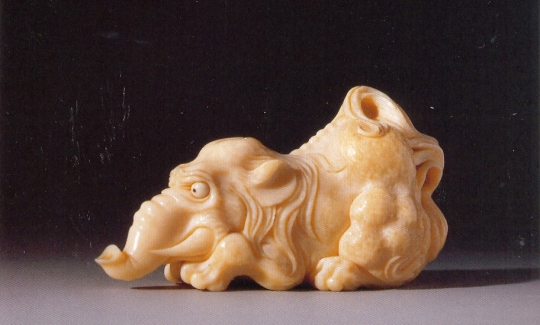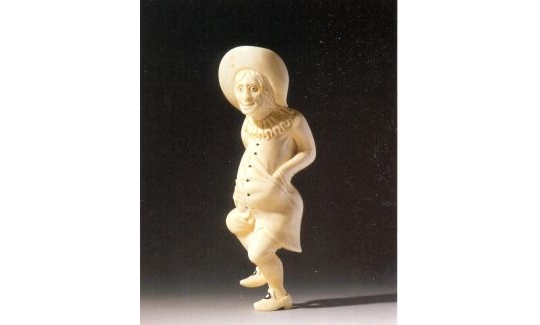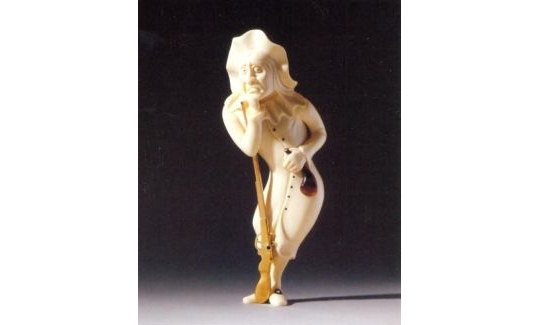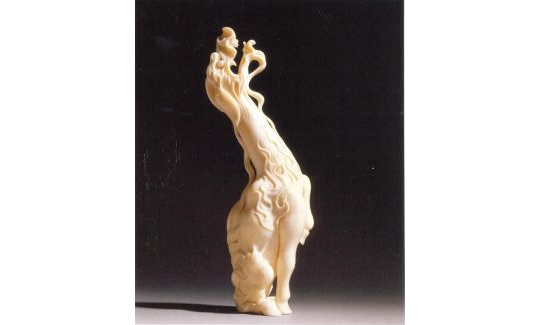Georges Weil was born in Vienna in 1938. His family moved to England one year later. Weil studied at the Central School of Art & Craft, and at St. Martin's School of Art in London. In 1956 he set up a studio for jewellery design and manufacture, while continuing his sculpture and painting. He made his first sculpture at the age of four. His sculptures include bronze portrait busts of Winston Churchill, Charles de Gaulle, David Ben-Gurion and others. His sculptures have been exhibited in London, Geneva, Tokyo, San Francisco and elsewhere. His work is to be found in famous private collections worldwide as well as several museums including the British Museum. At the end of the 1970s, Weil sold his successful jewellery business and decided to concentrate exclusively on his art.
Weil began collecting antique Japanese netsuke in the early 1960s and formedan important collection. In 1974, he began to make netsuke on the premise that "If the Japanese artists can make netsuke, then I can also try". He taught himself the techniques of carving, and soon established his reputation with two exhibitions at the D.J.K. Wright Ggallery in London.
In 1989 George Weil emigrated to Israel. For almost twenty years he did not make any netsuke so that all the netsuke on display have been created over the last two years, especially for this exhibition.
All Weil's talents as a painter, sculptor and maker of jewellery are united in his netsuke carvings. His subjects are living creatures - birds, fish, human - and those imaginary figures of legend that also inspired the traditional netsuke artists of Japan. Like them, Weil carves in wood, ivory, horn and other suitable materials. But he has also made use of interesting and unusual materials such as abalone shell, amber and 24 carat gold.
Essentially, Weil's netsuke fall into two categories. One is the traditional, very detailed Japanese type, but fashioned in his own unique style. He apparently started with this style in order to prove to himself that he was as dexterous as the early Japanese artists, but also because it is so different from his semi-abstract style (see further). His subjects usually derive from the Japanese netsuke tradition and from folklore, but are represented with Weil's daring originality, characteristic of his ability to represent dynamic creatures, both real and fabulous, that continue the tradition of the Japanese netsuke. Like the netuske of the Japanese artists Masanao of Kyoto, Okamoto Tomotada, and Kaigyokusai, who worked in the 18th century and at the beginning of the 19th century, Weil's carvings give one a sense of refinement, balance, and a spirit of poesy. However he does not confine himself to the Japanese tradition, either in choice of subject or in its interpretation, and he deliberately does not make his netsuke look antique.They are obviously the products of today.
His other motifs are semi-abstractions, compositions with clean, elegant lines. Here one can find stylized netsuke and simple, rounded, minimalistic forms, bringing to mind Zen paintings and the netsuke of Mitsuhiro, the 19th century Japanese artist. This apparent simplicity is deceptive. In fact, it is not easy to carve them, and demands the ability to select suitable material for a chosen subject, control of the medium, and great skill. Weil says that it is more difficult to eliminate detail then to add detail.
Weil's modus operandi is very interesting. He first makes pencil or ink sketches of ideas for netsuke in his notebook, as did the traditional netsuke artists. These are his only working notes before beginning a
project. He takes time to decide which of the many and varied sketches he will transform into a netsuke, and then continues to develop his selection, sketching a broad outline on the material of his choice. Weil also makes the tools he needs, from pieces of steal, as he needs them.
Like any sculptor, Weil "sees" the sculpture in his mind's eye. He carvers freely, and if he encounters problems arising from damage or faults in the material, he solves them so expertly, so that they are not evident in the finished product. Tiny details such as eyes are meticulously inlaid usually ivory, horn, or ebony. These are the final touches to his work, especially in his minimalistic carvings.
Sometimes, Weil uses gold as his medium and here his experience as a goldsmith stands him in good stead. Traditional netsuke made of gold from the 18th and 19th centuries are extremely rare. Since the mid-1980s Weil has occasionally made netsuke entirely of gold. His amazing dexterity in this medium and style is evidence of his old love for making jewellery.
Netsuke is a Japanese article originally intended for use as an accessory securing the inro (the container for a seal) to the sash. This is no longer necessary, but Japanese artists (though not many of them) continue the tradition of making netsuke. Sometimes they are commissioned by collectors. In such cases, the carving is often a copy, in the best Japanese tradition, rather than an original. Some experts prefer to relate to these as modern carvings in the netsuke style. When netsuke created by artists outside Japan first appeared, the question arose as to the definition of a "genuine" netsuke. Georges Weil believes that if these carvings with their prescribed dimensions still retain the potential of their original purpose, then they are to all intents and purposes, netsuke. However, like any objet d'art, the netsuke is also a miniature sculpture. Weil asserts, and proves, that western artists can also carve netsuke, and that there is no need to live in Japan in order to create them. In his opinion, the quality of the netsuke cannot be assessed according to the artist's nationality, but only according to criteria for judging the work itself. Contemporary netsuke must be carved in the same spirit as the antique netsuke. The netsuke artist must create something new, fresh, rather than a copy, something individual, for his work to be considered as art. Netsuke by artists who are not Japanese, like Weil himself, or who have been influenced by this artistic tradition but do not carve in the Japanese style, are creating a new netsuke style, and netsuke carving has become an international art form. At the end of the 1970s, the modern western netsuke was still a phenomenon of dubious provenance among experts and collectors alike. It was only in the mid-1980s that the latter began to collect them. Weil was the first western artist to be invited to join the Japanese Netsuke Chokokukai (The Japanese Netsuke Carvers Association), and the first foreign artist to participate in a group exhibition by its members.
Georges Weil's netuske are balanced and lovely works of art. All of them are evidence that he loves to create netsuke which, when we look at them, appear to be unable to stand on their own. Finding their equilibrium is what he particularly enjoys. Weil has also overcome the difficulty of creating the anatomical structure of fabulous creatures, and delineating facial expressions in his finely detailed carvings. He breathes life into his works by adapting material to subject, and creates a sense of movement in his tiny, immobile sculptures. The result is these charming, occasionally powerful grotesque little carvings, some of which have simple lines, and others which are more complicated. More than anything else, what characterizes Weil's works is their sculptural quality, because sculpture is his preferred medium of artistic expression.




